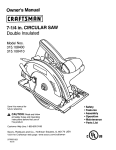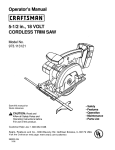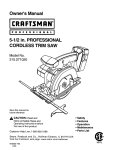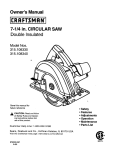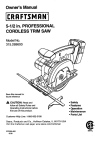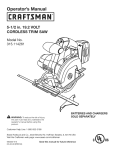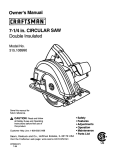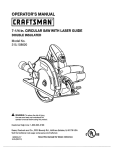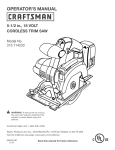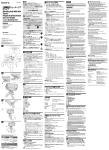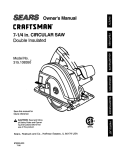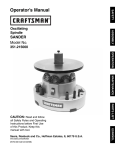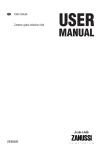Download Craftsman 315.108420 Owner`s manual
Transcript
Owner's Manual
II:RRFTSMRN'I
7-1/4 in. CIRCULAR SAW
Double Insulated
Model No.
315.108420
Save this manual
future reference.
_,
CAUTION:
for
•
•
•
•
•
•
Read and follow
all Safety Rules and Operating
Instructions before first use of
this product.
Customer
Help Line: 1-800-932-3188
Sears, Roebuck
and Co., Hoffman
Estates, IL 60179
Visit the Craftsman web page: www.sears.com/craftsman
972000-824
9-01
Safety
Features
Assembly
Operation
Maintenance
Parts List
USA
0( us
TABLE
OF CONTENTS
•
Table of Contents .............................................................................................................
•
General Safety Rules .....................................................................................................................................
2-3
•
Specific Safety Rules and/or Symbols ............................................................................................................
3-6
•
Features .........................................................................................................................................................
7-8
•
Assembly ........................................................................................................................................................
8-9
•
Operation ....................................................................................................................................................
10-17
•
Maintenance ...............................................................................................................................................
17-18
•
Accessories .....................................................................................................................................................
18
•
Exploded View and Repair Parts List .........................................................................................................
20-21
•
Parts Ordering / Service ...................................................................................................................................
,_
Keep your work area clean and well lit. Cluttered benches and dark areas invite accidents.
Personal
Do not operate power tools in explosive
atmospheres, such as in the presence of
flammable liquids, gases, or dust. Power tools
may create sparks which may ignite the dust or
fumes.
•
•
•
•
Double insulated tools are equipped with a
polarized plug (one blade is wider than the
other). This plug will fit in a polarized outlet
only one way. If the plug does not fit fully in the
outlet, reverse the plug. If it still does not fit,
contact a qualified electrician to install a
polarized outlet. Do not change the plug in any
way. Double insulation [] eliminates the need for
the three-wire grounded power cord and grounded
power supply system,
Dress properly. Do not wear loose clothing or
jewelry. Contain long hair. Keep your hair,
clothing, and gloves away from moving parts.
Loose clothes, jewelry, or long hair can be caught
in moving parts.
•
Avoid accidental starting. Be sure switch is off
before plugging in. Carrying tools with your
finger on the switch or plugging in tools that have
the switch on, invites accidents.
Remove adjusting keys or wrenches before
turning the tool on. A wrench or a key that is left
attached to a rotating part of the tool may result in
personal injury.
Do not overreach. Keep proper footing and
balance at all times. Proper footing and balance
enables better control of the tool in unexpected
situations.
Avoid body contact with grounded surfaces,
such as pipes, radiators, ranges, and refrigerators. There is an increased risk of electric shock if
your body is grounded.
Don't expose power tools to rain or wet conditions. Water entering a power tool will increase
the risk of electric shock.
•
Do not abuse the cord. Never use the cord to
carry the tools or pull the plug from an outlet.
Stay alert, watch what you are doing and use
common sense when operating a power tool.
Do not use tool while tired or under the influ-
•
Safety
•
Safety
ence of drugs, alcohol, or medication. A moment of inattention while operating power tools
may result in serious personal injury.
Keep bystanders, children, and visitors away
while operating a power tool. Distractions can
cause you to lose control.
Electrical
22
When operating a power tool outside, use an
outdoor extension cord marked "W-A" or "W".
These cords are rated for outdoor use and reduce
the risk of electric shock.
INSTRUCTIONS
Work Area
•
2
Keep cord away from heat, oil, sharp edges, or
moving pads. Replace damaged cords Immediately. Damaged cords increase the risk of electric
shock.
WARNING:
Read and understand all instructions. Failure to follow all instructions listed
below may result in electric shock, fire and/or
serious personal injury.
SAVE THESE
..................................
•
2
Use safety equipment. Always wear eye protection. Dust mask, nonskid safety shoes, hard hat,
or hearing protection must be used for appropriate
conditions.
Tool Use and Care
•
Use clamps or another practical way to secure
and support the workpiece to a stable platform. Holding the work by hand or against your
body is unstable and may lead to loss of control.
•
Do not force tool. Use the correct tool for your
application. The correct tool will do the job better
and safer at the rate for which it is designed.
•
Do not use tool if switch does not turn it on or
off. Any tool that cannot be controlled with the
switch is dangerous and must be repaired.
•
Disconnect the plug from power source before
making any adjustments, changing accessories, or storing the tool. Such preventive safety
measures reduce the risk of starting the tool
accidentally.
•
Store idle tools out of the reach of children and
other untrained persons. Tools are dangerous in
the hands of untrained users.
•
Maintain tools with care. Keep cutting tools
sharp and clean. Propedy maintained tools with
sharp cutting edges are less likely to bind and are
easier to control.
Specific
•
Safety
Rules for Circular
Check for misalignment or binding of moving
parts, breakage of parts, and any other condition that may affect the tool's operation, ff
damaged, have the tool serviced before using.
Many accidents are caused by poorly maintained
tools.
Use only accessories that are recommended
by the manufacturer for your model. Accessories that may be suitable for one tool, may become
hazardous when used on another tool.
Service
•
Tool service must be performed only by qualified repair personnel. Service or maintenance
performed by unqualified personnel could result in
a risk of injury.
•
When servicing a tool, use only identical
replacement parts. Follow instructions in the
Maintenance section of this manual. Use of
unauthorized parts or failure to follow Maintenance
Instructions may create a risk of electric shock or
injury.
Saws
lower guard into the open position. If saw
is accidentally dropped, lower guard may be
DANGER!
Keep hands away from cutting
area and blade. Keep your second hand on
the auxiliary handle or motor housing. If
bent. Raise the lower guard with the
retracting handle. Make sure it moves freely
and does not touch the blade or any other
part, in all angles and depths of cut.
both hands are holding the saw, they cannot
be cut by the blade.
•
jump backwards.
Prevention
•
•
Keep your body positioned to either side
of the saw blade, but not in line with the
saw blade. Kickback could cause the saw to
(See "Causes
and Operator
Check
the work. The
lower guard for proper
•
closing
before each use. Do not operate saw if
lower guard does not move freely and
close instantly.
of the
may operate sluggishly due to damaged
parts, gummy deposits, or a buildup of
debris.
guard cannot protect you from the blade
below the work.
•
and condition
lower guard spring. If the guard and the
spring are not operating properly, they
must be serviced before use. Lower guard
of Kickback.")
Do not reach underneath
Check the operation
Lower guard should be retracted manually
only for special cuts, such as "Pocket
Cuts" and "Compound
Cuts." Raise lower
guard by retracting handle. As soon as
blade enters the material, lower guard
must be released. For all other sawing, the
Never clamp or tie the
lower guard should operate automatically.
3
Specific Safety Rules for Circular Saws
(continued)
•
Always observe that the lower guard is
covering the blade before placing saw
down on bench or floor. An unprotected,
coasting blade will cause the saw to walk
backwards,
cutting whatever is in its path. Be
aware of the time it takes for the blade to
causing the blade to climb out of the kerf and
jump back toward the operator.
•
NEVER hold piece being cut in your hands
or across your leg. It is important to support
the work properly to minimize body exposure,
•
Maintain a firm grip with both hands on
the saw and position your body and arm
to allow you to resist KICKBACK forces.
KICKBACK forces can be controlled by the
operator, if proper precautions
are taken.
•
When
blade binding, or loss of control.
•
Hold tool by insulated gripping surface
when performing an operation where the
cutting tool may contact hidden wiring or
its own cord, Contact with a "live" wire will
•
When ripping, always use a rip fence or
straight edge guide. This improves the
accuracy of the cut and reduces the chance
for blade binding.
Always
use blades
with correct
blade binding.
•
•
•
•
of Kickback
Kickback is a sudden reaction to a pinched,
bound, or misaligned saw blade, causing an
uncontrolled
saw to lift up and out of the
workpiece
•
Prevention
toward the operator.
When the blade is pinched
•
If the blade becomes twisted or misaligned
in
the cut, the teeth at the back edge of the
blade can dig into the top surface of the wood
large panels to minimize the risk
pinching and KICKBACK.
Large
edge of the panel.
•
Do not use dull or damaged blade.
Unsharpened or improperly set blades
produce narrow kerf which causes excessive
friction, blade binding and KICKBACK.
•
or bound tightly
by the kerf closing down, the blade stalls and
the motor reaction drives the unit rapidly back
toward the operator.
Support
of blade
panels tend to sag under their own weight.
Supports must be placed under the panel on
both sides, near the line of cut and near the
bolts were specially designed for your saw for
optimum performance
and safety of
operation.
and Operator
into the
material. If saw blade is binding, it may walk
up or KICKBACK from the workpiece as the
saw is restarted.
Never use damaged or incorrect blade
washers or bolts. The blade washers and
Causes
When restarting
a saw in the workpiece,
center the saw blade in the kerf and check
that saw teeth are not engaged
size and
loss of control.
or when
complete stop. Never attempt to remove
the saw from the work or pull the saw
backward while the blade is in motion, or
KICKBACK
may occur. Investigate and take
corrective actions to eliminate the cause of
shape (diamond vs. round) arbor holes.
Blades that do not match the mounting
hardware of the saw will run eccentrically,
causing
blade is binding,
interrupting
a cut for any reason, release
the trigger and hold the saw motionless
in
the material until the blade comes to a
also make exposed metal parts of the tool
"live" and shock the operator.
•
is the result of tool misuse and/or
incorrect operating procedures or conditions
and can be avoided by taking proper
precautions,
as given below:
stop after switch is released.
•
Kickback
Blade depth and bevel adjusting locking
levers must be tight and secure before
making cut. If blade adjustment shifts while
cutting,
•
it may cause binding
and KICKBACK.
Use extra caution when making a "Pocket
Cut" into existing walls or other blind
areas. The protruding blade may cut objects
that can cause KICKBACK.
Hold tool by insulated gripping surfaces when performing an operation where the cutting tool may contact hidden wiring or its cord. Contact with a "live" wire will make exposed metal parts of the tool "live" and
shock the operator.
Additional
Rules For Safe Operation
•
Make sure your extension cord is in good
condition. When using an extension cord, be
sure to use one heavy enough to carry the
current your product will draw. A wire gage
size (A.W.G.) of at least 16 is recommended for
an extension cord 100 feet or less in length. A
cord exceeding 100 feet is not recommended.
If in doubt, use the next heavier gage. The
smaller the gage number, the heavier the cord.
An undersized cord will cause a drop in line
voltage resulting in loss of power and overheating.
•
Know your power tool. Read operator's manual
carefully. Learn its applications and limitations,
as well as the specific potential hazards
related to this tool. Following this rule will reduce
the risk of electric shock, fire, or serious injury.
•
Always wear safety glasses. Everyday eyeglasses have only impact-resistant lenses;
they are NOT safety glasses. Following this rule
will reduce the risk of serious personal injury.
•
Protect your lungs. Wear a face or dust mask if
the operation is dusty. Following this rule will
reduce the risk of serious personal injury.
•
Inspect for and remove all nails from lumber
before cutting. Following this rule will reduce the
risk of serious personal injury.
•
Protect your hearing. Wear hearing protection
during extended periods of operation. Following
this rule will reduce the risk of serious personal
injury.
•
Drugs, alcohol, medication. Do not operate tool
while under the influence of drugs, alcohol, or
any medication. Following this rule will reduce the
risk of electric shock, fire, or serious personal injury.
•
Inspect tool cords periodically and, if damaged, have repaired at your nearest Factory
Service Center or other Authorized Service
Organization. Constantly stay aware of cord
location. Following this rule will reduce the risk of
electric shock or fire.
•
Save these instructions. Refer to them frequently and use them to instruct others who
may use this tool. If you loan someone this
tool, loan them these instructions also.
_ILWARNING:
Some dust created by power
sanding, sawing, grinding, drilling, and other
construction activities contains chemicals known
to cause cancer, birth defects or other reproductive harm. Some examples of these chemicals
are:
Check damaged parts. Before further use of
the tool, a guard or other part that is damaged
should be carefully checked to determine that
it will operate properly and perform its intended function. Check for alignment of moving parts, binding of moving parts, breakage of
parts, mounting, and any other conditions that
may affect its operation. A guard or other part
that is damaged should be properly repaired or
replaced by an authorized service center.
Following this rule will reduce the risk of shock,
fire, or serious injury.
• lead from lead-based
paints,
• crystalline silica from bricks and cement
and other masonry products, and
• arsenic and chromium from chemicallytreated lumber.
Your risk from these exposures varies,
depending on how often you do this type of
work. To reduce your exposure to these
chemicals: work in a well ventilated area, and
work with approved safety equipment, such as
those dust masks that are specially designed to
filter out microscopic particles.
Do not abuse cord. Never carry the tool by the
cord or yank it to disconnect it from the receptacle. Keep cord away from heat, on, and sharp
edges. Following this rule will reduce the risk of
electric shock or fire.
_IL WARNING:
The operation of any circular saw can result in foreign objects being thrown into your eyes,
which can result in severe eye damage. Before beginning power tool operation, always wear
safety goggles or safety glasses with side shields and a full face shield when needed. We
recommend Wide Vision Safety Mask for use over eyeglasses or standard safety glasses
with side shields, available at Sears Retail Stores.
5
SYMBOLS
SYMBOL
NAME
DESIGNATION/EXPLANATION
V
Volts
Voltage
A
Amperes
Current
Hz
Hertz
Frequency (cycles per second)
rain
Minutes
Time
Alternating Current
Type or a characteristic of current
._
Direct Current
Type or a characteristic of current
no
No Load Speed
Rotational speed, at no load
]
Class II Construction
Designates
Construction Double
Tools Insulated
.../min
Revolutions or Reciprocation
Per Minute
Revolutions, strokes, surface
speed, orbits etc. per minute
Indicates danger, warning or caution.
,_
Safety Alert Symbol
It means attention!!! Your safety is
involved.
The purpose of safety symbols is to attract your attention to possible dangers. The safety symbols, and
the explanations with them, deserve your careful attention and understanding. The safety warnings do
not by themselves eliminate any danger. The instructions or warnings they give are not substitutes for
proper accident prevention measures.
SYMBOL
MEANING
A
SAFETY ALERT SYMBOL:
A
A
A
DANGER: Failure to obey a safety warning will result in serious injury to yourself or to others.
Always follow the safety precautions to reduce the risk of fire, electric shock, and personal injury.
NOTE:
Indicates danger, warning, or caution. May be used in conjunction
pictographs.
with other symbols or
WARNING: Failure to obey a safety warning can result in serious injury to yourself or to others.
Always follow the safety precautions to reduce the risk of fire, electric shock, and personal injury.
CAUTION: Failure to obey a safety warning may result in property damage or personal injury to
you rself or to others. Always follow the safety precautions to reduce the risk of fire, electric shock,
and personal injury.
Advises you of information or instructions vital to the operation or maintenance of the equipment.
SAVE THESE INSTRUCTIONS
6
Yourcircular saw
has been shipped completely
assembled except for the blade. Inspect it carefully to
make sure no breakage or damage has occurred
during shipping. If any parts are damaged or missing,
contact your nearest Sears Retail Store to obtain
replacement parts before attempting to operate saw. A
blade, blade wrench, and this owner's manual are also
included.
3
Horsepower
Input
Blade Diameter
13 Amperes
7-1/4 in. (184 mm)
Blade Arbor
5/8 in. (16 mm)
Cutting Depth at 0° Bevel Cut
KNOW YOUR CIRCULAR
SAW
Before attempting to use any tool, familiarize yourself
with all operating features and safety requirements.
Your circular saw has many features for making
cutting operations more pleasant and enjoyable.
Safety, performance and dependability have been
given top priority in the design of this saw making it
easy to maintain and operate.
Features include easily operated bevel cut and depth
of cut adjustment mechanisms, positive O° bevel stop,
length of cut scale, depth of cut scale, directed air flow
for keeping line of cut clear, blade wrench storage,
dust chute, and spindle lock.
CAUTION: Carefully read through this entire
owner's manual before using your new circular
saw. Pay close attention to the Rules For Safe
Operation, Warnings and Cautions. If you use
your circular saw properly and only for what it is
intended, you will enjoy years of safe, reliable
service.
APPLICATIONS
(Use only for the purpose listed below)
•
WARNING:
If any parts are missing, do not
operate this tool until the missing parts are
replaced. Failure to do so could result in possible
serious personal injury.
Cutting Depth at 45 ° Bevel Cut
Cutting Depth at 51.5 ° Bevel Cut
Rating
1-13/16 in. (46 mm)
1-5/8 in. (41 mm)
120 volts, 60 Hz, AC
5,500 RPM
No Load Speed
2-3/8 in. (60 mm)
See Figure 1.
_
_L
Cutting all typos of wood products (lumber,
plywood, paneling).
ELECTRICAL
CONNECTION
Your circular saw has a precision built electdc motor. It
should be connected to a power supply that is 120
volts, 60 Hz, AC only (normal household current). Do
not operate this tool on direct current (DC). A substantial
voltage drop willcause a loss of power and the motor
will overheat. If your saw does not operate when
plugged into an outlet, double-check !he power supply.
SWITCH
To turn your saw ON, depress the switch trigger.
Release switch trigger to turn your saw OFF.
DUST CHUTE
To direct saw dust and chips away from the operator,
a dust chute is located on the side of the upper blade
guard. An optional dust nozzle kit, that fits over the
dust chute, is available at your nearest Sears Retail
Store.
SPINDLE
LOCK BU'I-I'ON
A spindle lock button has been provided for locking the
spindle on your saw in a stationary position.
d_lL WARNING:
Do not allow familiarity with your
saw to make you careless. Remember that a
careless fraction of a second is sufficient to inflict
severe injury.
SWITCH
TRIGGER
UPPER
BLADEGUARD
LOWER
BLADE
GUARD
HANDLE
DUST
CHUTE
_
BEVELCUT
ADJUSTMENT
(BEVELADJUSTMENTKNOB)
SPINDLE
LOCKBUTrON
BASE
ASSEMBLY
LOWER
BLADEGUARD
BLADE
DEPTHOF
CUTSCALE
DEPTHOF
CUTADJUSTMENT
(DEPTHADJUSTMENTKNOB)
BLADEWRENCH
STORAGEAREA
BLADEWRENCH
WARNING: Your saw should never be
connected to power supply when you are
assembling parts, making adjustments,
assembling or removing blades, cleaning, or
when not in use. Disconnecting your saw will
prevent accidental starting that could cause
serious personal injury.
,_i
Fig. 1
WARNING: A 7-1/4 in. blade is the maximum
blade capacity of your saw. Never use a blade that
is too thick to allow outer blade washer to engage
with the flat on the spindle. Larger blades will come
in contact with the blade guards, while thicker
blades will prevent blade screw from securing
blade on spindle. Either of these situations could
result in a serious accident.
TO ASSEMBLE
OR REMOVE
•
BLADE
See Figures 2, 3, and 4.
•
_
Unplug your saw.
OUTERBLADEWASHER("D" WASHER)
WARNING:
Failure to unplug your saw could
result in accidental starting causing possible
serious personal injury.
SPINDLE
LOCK
BUTTON
A spindle lock button has been provided for locking the
spindle on your saw in a stationary position. Depress
and hold the spindle lock button while installing, changing
or removing the blade.
TO ASSEMBLE BLADE:
•
•
CUPPEDSIDE OF
SPRINGWASHER
Remove blade wrench from storage area.
See Figure 1.
OUTSIDEOF
SPRINGWASHER
Fig, 3
•
Depress spindle lock button, then replace blade
screw. Tighten blade screw securely.
Note: Turn blade screw clockwise to tighten.
• Return blade wrench to storage area.
Note: Always place angled portion of blade
wrench up as shown in Figure 1.
REMEMBER: Never use a blade that is too thick to
Position your saw as shown in Figure 4, depress
spindle lock button, and remove blade screw. See
Figure 2.
Note: Tum blade screw counterclockwise to remove.
•
Replace "D" washer and spring washer.
Note: "Cupped" side of spring washer goes
against "D" washer. See Figure 3.
Remove spring washer, and outer blade washer
("D" washer). See Figure 2.
_
__
SPINDLE
/
LOWERBLADE
_/
GUARDHANDLE
allow the "D" washer to engage with the flat on
the spindle.
TO REMOVE BLADE:
•
Remove blade wrench from storage area.
See Figure 1.
•
Position your saw as shown in Figure 4, depress
spindle lock button, and remove blade screw.
Note: Turn blade screw counterclockwise to remove.
•
Remove spring washer and outer blade washer
("D" washer). See Figure2.
Note: Blade can be removed at this poinL
DEPRESSTO LOCK
SPINDLELOCKBUTTON
FLANGEBUSHING _
WASHER-("D" WASHER)
_)-./
_
/
SPRING/
WASHER
•
_k
•
/
"=_"
Fig. 2
Wipe a drop of oil onto inner flange bushing and
outer blade washer ("D" washer) where they
contact blade.
WARNING:
If inner flange bushing has been
removed, replace it before placing blade on
spindle. Failure to do so could cause an accident
since blade will not tighten properly.
TO
TIGHTEN
BLADESCREW
Fit saw blade inside lower blade guard and onto
spindle. Note: The saw teeth point upward at the
front of saw as shown in Figure 2.
TO
LOOSEN
9
BLADE
WRENCH
Fig. 4
SAW BLADES
KICKBACK
The best of saw blades will not cut efficiently if they
are not kept clean, sharp, and properly set. Using a
dull blade will place a heavy load on your saw and
increase the danger of kickback. Keep extra blades
on hand, so that sharp blades are always available.
See Figure 6.
Gum and wood pitch hardened on blades will slow
your saw down. Use gum and pitch remover, hot
water, or kerosene to remove these accumulations.
Do not use gasoline.
BLADE
GUARD
SYSTEM
The lower blade guard attached to your circular
saw is there for your protection and safety. It
should never be altered for any reason. If it
becomes damaged or begins to return slow or
sluggish, do not operate your saw until the
damage has been repaired or replaced. Always
leave guard in operating position when using saw.
_i
BLADESETTOO DEEP
The best guard against kickback is to avoid
dangerous practices.
Kickback occurs when the blade stalls rapidly and the
saw is driven back towards you. Blade stalling is
caused by any action which pinches the blade in the
wood.
DANGER: When sawing through workpiece,
lower blade guard does not cover blade on the
underside of workpiece. Since blade is exposed
on underside of workpiece, keep hands and
fingers away from cutting area. Any part of your
body coming in contact with moving blade will
result in serious injury. See Figure 5.
_i
,_
DANGER: Release switch immediately if blade
binds or saw stalls. Kickback could cause you to
lose control of your saw. Loss of control can lead
to serious injury.
KICKBACK
LOWERBLADEGUARD
IS IN UP POSITION
BLADEEXPOSEDON
UNDERSIDEOF WORKPIECE
Fig. 6
IS CAUSED
BY:
•
Incorrect blade depth setting. See Figure 6.
•
Sawing into knots or nails in workpiece.
•
Twisting blade while making a cut.
•
Making a cut with a dull, gummed up, or improperly
set blade.
•
Incorrectly supporting workpiece. See Figure 7.
Fig. 5
CAUTION: Never use saw when guard is not
operat In g co rr ectly. Guard should be checked for
correct operation before each use. If you drop
your saw, check the lower blade guard and
bumper for damage at all depth settings before
reuse. Note: The guard is operating correctly
when it moves freely and readily returns to the
closed position. If for any reason your lower
blade guard does not close freely, take it to the
nearest Sears Repair Center for service before
using.
WRONG
10
•
Forcing a cut.
•
Cutting warped or wet lumber.
•
Tool misuse or incorrect operating procedures.
Fig. 7
TO LESSEN
•
THE CHANCE
OF KICKBACK:
Always keep the correct blade depth setting - the
correct blade depth setting for all cuts should not
exceed 1/4 inch below the material to be cut. See
•
When making a cut use steady, even pressure.
Never force cuts.
•
Do not cut warped or wet lumber.
•
Always hold your saw firmly with both hands and
keep your body in a balanced position so as to
resist the forces of kickback should it occur.
Figure 8.
When using your saw, always stay alert and
exercise control. Do not remove your saw from
workpiece while the blade is moving.
DEPTH
OF CUT ADJUSTMENT
See Figure 10.
Always keep correct blade depth setting. The correct
blade depth setting for all cuts should not exceed 1/4
inch below the material to be cut. More blade depth
will increase the chance of kickback and cause the cut
to be rough. For more depth of cut accuracy, a scale
is located on the upper blade guard.
TO ADJUST
•
CORRECTBLADE DEPTHSETTING= BLADEEXPOSED
1/4 in. OR LESS ON UNDERSIDEOF WORKPIECE
Fig. 8
•
Inspect the workpiece for knots or nails before
beginning a cut. Never saw into a knot or nail.
•
Make straight cuts. Always use a straight edge
guide when rip cutting. This helps prevent twisting
the blade in the cut.
•
Always use clean, sharp and properly set blades.
Never make cuts with dull blades.
•
To avoid pinching the blade, support the workpiece
properly before beginning a cut. The right and
wrong ways to support large pieces of work are
shown in Figures 7 and 9.
BLADE
DEPTH
Unplug your saw.
_k
WARNING:
Failure to unplug your saw could
result in accidental starting causing possible
serious personal injury.
BRACKET
DEPTH
ADJUSTMENT
KNOB
DEPTHOF
CUTSCALE
TO
TIGHTEN
BAS
ASSEMBLY
•
Loosen depth adjustment knob. See Figure 10.
•
Determine the desired depth of cut.
•
Locate depth of cut scale on back of upper blade
guard.
•
Hold base flat against the workpiece and raise or
lower saw until the indicator mark on bracket aligns
with notch on blade guard.
•
Tighten depth adjustment knob securely.
I
RIGHT
Fig. 9
11
f TO RAISE
q TO LOWER
Fig. lO
STARTING
TO HELP MAINTAIN
A CUT
Know the right way to use your saw.
See Figure 11.
CONTROL:
•
Always support your workpiece near the cut.
•
Support your workpiece so the cut will be on your
right.
•
Clamp your workpiece so it will not move during
the cut.
Place your workpiece with its good side down. Note:
The good side is the side on which appearance is
important.
Before beginning a cut, draw a guideline along the
desired line of cut. Then place front edge of base on
that part of your workpiece that is solidly supported.
See Figure 11.
Never place your saw on that part of the
workpiece that will fall off when the cut is made.
See Figure 13.
RIGHT
_L
Fig. 11
WARNING:
To make sawing easier and safer,
always maintain proper control of your saw. Loss
of control of your saw could cause an accident
resulting in possible serious injury.
Never use your saw as shown in Figure 12.
WRONG
Fig. 13
Keep the cord away from cutting area. Always place
the cord to prevent it from hanging up on the
workpiece while making a cut.
WRONG
,_
DANGER: If the cord hangs up on the
workpiece during a cut, release the switch trigger
immediately. Unplug your saw and reposition the
cord to prevent it from hanging up again.
_L
DANGER: Using your saw with a damaged cord
could result in serious injury or death. If the cord
has been damaged, have it replaced before
using your saw again.
Fig. 12
Never place your hand on the workpiece behind
your saw while making a cut.
12
Hold your saw firmly with both hands.
See Figure 14.
_k
CAUTION:
When lifting your saw from the
workpiece, the blade is exposed on the
underside of your saw until the lower blade guard
closes. Make sure lower guard is closed before
setting your saw down on work surface.
TO CROSS
CUT OR RIP CUT
When making a cross cut or rip cut, align your line of
cut with the outer blade guide notch on the saw base
as shown in Figure 15.
FRONT
OF SAW
RIGHT
Fig. 14
Squeeze the switch trigger to start your saw. Always
let the blade reach full speed, then guide your saw
into the workpiece.
,_
WARNING:
The blade coming in contact with
the workpiece before it reaches full speed could
cause your saw to "kickback" towards you
resulting in serious injury.
GUIDELINE
ALIGN OUTERBLADEGUIDENOTCHON SAW BASE
WITH LINE OF CUTAS SHOWNWHENMAKING
CROSSCUTSOR RIP CUTS
Fig. 15
When making a cut use steady, even pressure.
Forcing causes rough cuts, could shorten the life of
your saw and could cause "kickback."
REMEMBER:
Since blade thicknesses vary, always make a trial cut
in scrap material along a guideline to determine how
much, if any, the guideline must be offset to produce
an accurate cut. Note: The distance from the line of
When sawing through work, the lower blade guard
does not cover the blade, exposing it on the
underside of work. Keep your hands and fingers
away from cutting area. Any part of your body
coming in contact with the moving blade will
result in serious injury.
cut to the guideline is the amount you should offset
the guideline.
After you complete your cut release the trigger and
allow the blade to come to a complete stop. Do not
remove your saw from workpiece while the blade
is moving.
13
TO BEVEL
CUT
When making a bevel cut hold your saw firmly with
both hands as shown in Figure 17.
The angle of cut of your saw may be adjusted to any
desired setting between zero and 51.5 °. Note: When
making cuts at 51.5 ° blade should be set at full depth
of cut, with edge guide screw removed.
Rest the front edge of the base on the workpiece.
Squeeze the switch trigger to start your saw. Always
let the blade reach full speed, then guide your saw
into the workpiece.
When making 45 ° bevel cuts, there is a notch in the
saw base to help you line up the blade with the line of
cut. See Figure 16.
I I
L:_'_'_:
EL ADJUSTMENT
BEVELADJUSTMENTKNOB)
LOWER
BLADEGUARD
Fig. 17
,_
GUIDELINE
BLADE
GUIDENOTCH
BEVEL
SCALE
WARNING:
The blade coming in contact with
the workpiece before it reaches full speed could
cause saw to "kickback" toward you resulting in
serious injury.
After you complete your cut release the trigger and
allow the blade to come to a complete stop. After the
blade has stopped, lift your saw from the workpiece.
ALIGN INNERBLADEGUIDENOTCHON SAW BASEWITH
LINE OF CUTAS SHOWNWHENMAKING45° BEVELCUTS
Fig. 16
TO ADJUST
Align your line of cut with the inner blade guide notch
on the saw base when making 45 ° bevel cuts.
•
Since blade thicknesses vary and different angles
require different settings, always make a trial cut
in scrap material along a guideline to determine
how much you should offset the guideline on the
board to be cut,
BEVEL SE'n'ING
Unplug your saw.
WARNING:
Failure to unplug your saw could
result in accidental starting causing possible
serious personal injury.
•
Locate bevel adjustment knob located at the front
of saw and loosen. See Figure 16.
•
Raise motor housing end of saw until you reach
desired angle setting on bevel scale.
See Figure 16.
•
Tighten bevel adjustment knob securely.
,_
14
WARNING:
Attempting bevel cut without bevel
adjustment knob securely tightened, can result in
serious injury.
POSITIVE
O° BEVEL
STOP
TO ADJUST
See Figure 18.
BEVEL
ADJUSTMENT
KNOB
•
ADJUSTMENT
SCREW
_k
•
PosmVE_BEVELSTOP
CARPENTER'S
SQUARE
SAW BLADE
WARNING:
Failure to unplug your saw could
resutt in accidental starting causing possible
serious personal injury.
Loosen bevel adjustment knob.
•
Loosen hex nut securing adjustment screw.
•
Turn screw and adjust base until square with saw
blade.
•
Tighten hex nut and bevel adjustment knob
securely.
,_
HEXNUT
Unplug your saw.
WARNING:
Attempting to make cuts without
bevel adjustment knob securely tightened can
result in serious injury.
LENGTH
OF CUT SCALE
See Figure 19.
Fig. 18
Your saw has a positive 0° bevel stop, that has been
factory adjusted to assure 0° angle of your saw blade
when making 90 ° cuts. However, misalignment can
occur during shipping.
TO CHECK
•
Unplug your saw.
LENGTHOF CUT SCALE
,_k WARNING:
Failure to unplug your saw could
result in accidental starting causing possible
serious personal injury.
•
Place your saw in an upside down position on
workbench. See Figure 18.
•
Using a carpenter's square, check squareness
saw blade to the base of your saw.
Fig. 19
A length of cut scale has been provided on the base
of your saw. It is parallel with the saw blade and can
be used to measure the distance into material the
blade has cut. Note: Six inches is the maximum
rength of cut that can be measured. Also, it is
accurate only when the depth of cut is set at full
maximum depth.
of
15
TO POCKET
CUT
C-clamps, firmly clamp a straight edge to the
workpiece and guide the saw along the straight edge
to achieve a straight rip cut. Do not bind the blade in
the cut. If using the rip guide provided, see the
following instructions and Figure 22.
See Figure 20.
LOWER
BLADEGUARD
ALTERNATEMETHODFORRIP CUTTING
STRAIGHT
EDGE
POCKETCUT
,_
LOWERBLADE
GUARD HANDLE
Fig. 20
WORKPIECE
C-CLAMPS
WARNING: Always adjust bevel setting to zero
before making a pocket cut. Attempting a pocket
cut at any other setting can result in loss of control
of your saw possiblycausing serious injury.
Fig. 21
TO ASSEMBLE
•
Adjust the bevel setting to zero, set blade to correct
blade depth setting, and swing the lower blade guard
up using the lower blade guard handle.
,_
Always raise the lower blade guard with the
handle to avoid serious injury.
•
While holding lower blade guard by the handle, firmly
rest the front of the base flat against the workpiece
with the rear of the handle raised so the blade does
OPTIONAL
RIP GUIDE
Unplug your saw.
WARNING:
Failure to unplug your saw could
result in accidental starting causing possible
serious personal injury.
Place rip guide through holes in saw base as
shown in Figure 22.
RIP
GUIDE
not touch the workpiece. See Figure 20.
Squeeze the switch trigger to start your saw. Always
let the blade reach full speed then slowly lower
blade into the workpiece until base is flat against
workpiece.
After you complete your cut release the trigger and
allow the blade to come to a complete stop. After the
blade has stopped, remove it from the workpiece.
Corners may then be cleared out with a hand saw or
sabre saw.
_i
RIP GUIDE
(EDGEGUIDE)
PLACERIP
GUIDETHRU HOLES
WARNING:
Never tie the lower blade guard in a
raised position. Leaving the blade exposed could
lead to serious injury.
Fig. 22
TO RIP CUT
OPTIONAL
RIP GUIDE
(EDGE
GUIDE)
See Figure 2t.
•
Adjust rip guide to the width needed.
•
Tighten rip guide screw securely.
When using a rip guide, position the face of the rip
guide firmly against the edge of workpiece. This
makes for a true cut without pinching the blade. The
guiding edge of workpiece must be straight for your
cut to be straight. Use caution to prevent the blade
from binding in the cut.
Use a guide when making long or wide rip cuts with
your saw. An optional rip guide with a five inch scale
is available at your Sears Retail Store or you can
make an efficient rip guide by clamping a straight
edge to your workpiece. Secure the workpiece. Using
16
OPTIONALDUSTNOZZLEKIT
UPPER
BLADEGUARD
See Figure 23.
An optional dust nozzle kit, part no. 982829-001, is
available for purchase at your nearest Sears Retail
Store. As shown in Figure 23, the adapter fits over the
dust chute which is located on the upper blade
guard.The nozzle attaches to the adapter.
Note: If you use the nozzle, you should always
connect it to a standard vacuum hose.
TO A'n'ACH
•
DUST NOZZLE
KIT
Unplug your saw.
_IWARNING:
Failure to unplug your saw could
result in accidental starting causing possible
serious personal injury.
•
Orient adapter to fit into the dust chute opening (1)
on upper blade guard. Secure adapter with screw
(2) provided.
•
When using a vacuum hose, align hole in nozzle
with raised lip on adapter and snap into place (3).
ADAPTER
CHUTE
RAISEDLIP
HOLE
_
NOZZLE
Fig. 23
GENERAL
It has been found that electric tools are subject to
accelerated wear and possible premature failure when
they are used on fiberglass boats, sports cars,
wallboard, spackling compounds, or plaster. The
chips and grindings from these materials are highly
abrasive to electric tool parts, such as bearings,
brushes, commutators, etc. Consequently, it is not
recommended that this tool be used for extended
Only the parts shown on parts list, page 21, are
intended to be repaired or replaced by the customer.
All parts represent an important part of the double
insulation system and should be serviced only at a
Sears Service Center.
Avoid using solvents when cleaning plastic parts.
Most plastics are susceptible to damage from various
types of commercial solvents and may be damaged
by their use. Use clean cloths to remove dirt, carbon
dust, etc.
work on any fiberglass material, wallboard, spackling
compounds, or plaster. During any use on these
materials, it is extremely important that the tool is
cleaned frequently by blowing with an air jet.
LUBRICATION
,_IWARNING:
Do not at any time let brake fluids,
gasoline, petroleum-based products, penetrating
oils, etc. come in contact with plastic parts. They
contain chemicals that can damage, weaken or
destroy plastic.
All of the bearings in this tool are lubricated with a
sufficient amount of high-grade lubricant for the life of
the unit under normal operating conditions. Therefore,
no further lubrication is required.
_i
17
WARNING: Always wear safety goggles or
safety glasses with side shields during power tool
operation or when blowing dust. If operation is
dusty, also wear a dust mask.also wear a dust
mask.
DOUBLE
INSULATION
A wire gage size (A.W.G.) of at least 16 is recommended for an extension cord 100 feet or less in
length. When working outdoors, use an extension
cord that is suitable for outdoor use. The cord's jacket
will be marked WA.
Double insulation is a concept in safety in electric
power tools, which eliminates the need for the usual
three-wire grounded power cord. All exposed metal
parts are isolated from the internal metal motor
components with protecting insulation. Double
insulated tools do not need to be grounded.
_k
CAUTION: Keep extension cords away from the
cutting area and position the cord so that it will
not get caught on lumber, tools, etc., during
cutting operation.
_k
WARNING:
Check extension cords before each
use. If damaged replace immediately. Never use
tool with a damaged cord since touching the
damaged area could cause electrical shock
resulting in serious injury.
IMPORTANT
Servicing of a tool with double insulation requires
extreme care and knowledge of the system and
should be performed only by a qualified service
technician. For service, we suggest you return the tool
to your nearest Sears Service Center for repair.
Always use original factory replacement parts when
servicing.
EXTENSION
CORDS
Extension cords suitable for use with your saw are
available at your nearest Sears Retail Store.
The use of any extension cord will cause some loss of
power. To keep the loss to a minimum and to prevent
tool overheating, use an extension cord that is heavy
enough to carry the current the tool will draw.
The following recommended
accessories
are currently available at Sears Retail Stores.
•
7-1/4 in.
40 Tooth General Purpose Cut-Off Blade
•
7-1/4 in.
35 Tooth Master Combination
•
7-1/4 in.
200 Tooth Plywood Blade
•
7-1/4 in.
18 Tooth Carbide Blade
•
7-1/4 in.
18 Tooth Mach II Silver Series Carbide Blade
•
7-1/4 in.
24 Tooth Mach II Silver Series Carbide Blade
•
7-1/4 in.
24 Tooth Combination
•
Rip Guide
Blade
Carbide Blade
Dust Nozzle Kit - Part No. 982829-001
_kWARNING:
The use of attachments or accessories not listed might be hazardous.
WARRANTY
FULL ONE YEAR WARRANTY
ON CRAFTSMAN
CIRCULAR SAW
If this rRRFT$14RN Circular Saw fails to give complete satisfaction within one year from the date of purchase,
RETURN IT TO THE NEAREST SEARS STORE OR SEARS SERVICE CENTER IN THE UNITED STATES,
and Sears will repair it, free of charge
If this rRRFTSMRN Circular Saw is used for commercial or rental purposes, this warranty applies for only 90
days from the date of purchase.
This warranty gives you specific legal rights, and you may also have other rights which vary from state to state.
Sears, Roebuck and Co., Dept. 817WA, Hoffman Estates, IL 60179
18
19
CRAFTSMAN
CIRCULAR
SAW - MODEL
NUMBER
315.108420
2
1
SEE NOTE"A"PAGE21
3
23
4
5
8
6
9
10
14
11
12
24
23
13
15
22
29
16
21
28
27
20
18
17
19
20
'
CRAFTSMAN
I
SAW
- MODEL
NUMBER
315.108420
The model number will be found on a plate attached to the motor housing. Always mention the model number in all correspondence
CIRCULAR SAW or when ordering repair parts.
SEE
Key
No.
CIRCULAR
BACK
PAGE
FOR
PARTS
ORDERING
PARTS
LIST
Part
Number
Description
Quan.
regarding your
INSTRUCTIONS
Key
No.
Part
Number
Description
Quart,
1
982597-001
Data Plate .......................................................
1
17
612999-001
Blade Screw ...................................................
2
982498-001
Scale Decal ....................................................
1
18
621433-007
Carriage Bolt (1/4-20 x 4 in.) .......................... 1
3
982820-001
Logo Plate ......................................................
1
19
3053002
4
974900-001
Bumper ...........................................................
1
20
931744-059
Base Assembly ...............................................
Flat Washer ....................................................
1
2
5
982492-131
* Screw (#8-32 x 3/4 in. Fil. Hd.) ....................... 1
21
941401-310
Roll Pin ...........................................................
1
6
617096-002
Retaining Ring ................................................
1
22
979848-003
Knob ...............................................................
2
7
**STD315535
Ball Bearing ....................................................
1
23
706404-007
Hex Nut (#8-32) **STD541008 ....................... 1
8
982828-001
Lower Blade Guard Support ........................... 1
24
614658-010
* Screw (#8-32 x 5/8 in. Pan Hd.) ..................... 1
* Screw (#8-32 x 3/8 in. Pan Hd.) ..................... 3
25
982822-001
Gear and Spindle Assembly ........................... 1
1
9
610122-003
10
967952-001
Torsion Spring ................................................
1
26
621433-001
Carriage Bolt (1/4-20 x 5/8 in.) **STD532507
1
11
982380-001
Lower Blade Guard Assembly ........................ 1
27
5542303
Spacer ............................................................
1
12
7186O2-8O4
Retaining Ring ................................................
1
28
974716-001
Wrench ...........................................................
1
13
967887-003
Inner Flange Bushing .....................................
1
29
982832-001
Warning Tag ...................................................
1
Saw Blade 7-1/4 in. for 5/8 in. Arbor ............... 1
30
982829-001
Optional Dust Nozzle Assembly (Not Shown)
15
998463-001
Outer Blade Washer .......................................
1
31
16
623547-002
Washer ...........................................................
1
14
***
972000-824
*
**
***
Optional Rip Guide (Item No. 9-27679)
(Not Shown)
Owner's Manual
Standard Hardware Item -- May Be Purchased Locally
Available From Div.96-- Source 980.00
Complete Assortment Available At Your Nearest Sears Retail Store
NOTE: "A"- The assembly shown represents an important part of the Double insulated System. To avoid the possibility of alteration or damage
to the system, service should be performed by your nearest Sears Repair Center. Contact your nearest Sears Retail Store for
Service Center information.
21
Get it fixed, atyour home or ours!
For repair of major brand appliances in your own home...
no matter who made it, no matter who sold it{
1-800-4-MY-HOME
sMAnytime,
day or n,ght
(1-800-469-4663)
www.sears.com
To bring in products such as vacuums, lawn equipment and electronics
for repair, call for the location of your nearest Sears Parts & Repair Center.
1-800-488-1222
Anytime,
day or night
www.sears,com
For the replacement parts, accessories and owner's manuals
that you need to do-it-yourself, call Sears PartsDirect su !
1-800-366-PART
6 a m -
(1-800-366-7278)
11 p m. CST,
7 days a week
www.sears.com/partsdirect
To purchase
or =nquire about a Sears Service Agreement:
1-800-827-6655
7 a m - 5 p.m. CST, Men
Para ped_r servlc_o de reparaclon a domlclho,
y para ordenar p_ezas con entrega a dom_cfl_o
1-888-SU-HOGAR
s_'
(1-888
S_' Irs
Roebuck
and
GO
Au Canada
pour service
1-877-LE-FOYER
(1-877"533-6937)
784-6427)
'_>Re,j_'>lered
r
- Sat
_ Marca
Trademark
Reg=slracia
t r_ Trademark
/ TM Marca
_3e Fabrlca
of Sears
de
Sears
Roebuck
ROebuCk
and
and
Co
Co
en fran£a_s
_M






















